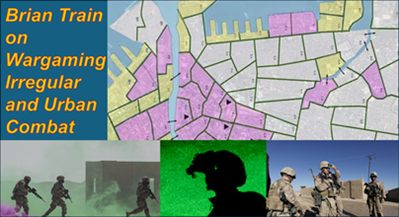[Editor’s Note: This past spring, Army Mad Scientist sought to crowdsource the intellect of the Nation (i.e., you — our community of action!) with our Calling all Wargamers flyer, soliciting input about your wargaming experiences:
-
-
- What are you learning about Large-Scale Combat Operations (LSCO)?
-
-
-
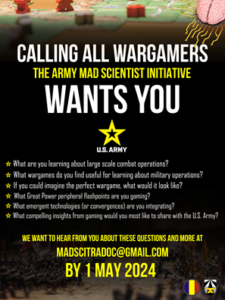 What wargames do you find useful for learning about military operations?
What wargames do you find useful for learning about military operations?
-
-
-
- If you could imagine the perfect wargame, what would it look like?
-
-
-
- What Great Power peripheral flashpoints are you gaming?
-
-
-
- What emergent technologies (or convergences) are you integrating into your wargaming?
-
-
-
- What compelling insights from gaming would you most like to share with the U.S. Army?
-
Today’s post features the latest in our continuing series presenting what we’ve learned about wargaming from your many responses — I am confident they will pique your interest in attending our Game On! Wargaming & The Operational Environment conference this November at Georgetown University — check out the 5Ws at the end of this post for more information about this event, then drop us an email if you’d like to receive an invitation to attend!
Brian Train — a freelance writer and prolific wargame designer for both the commercial hobbyist community and the U.S. and Canadian Armies — provides many insightful and keen observations on wargaming from an irregular warfare and urban combat perspective. His invaluable “nuggets” include: a prescription for enhancing games by injecting “… pieces of ‘realism’ that only rarely get picked up in hobby wargames, if at all. They often don’t show up in professional wargames played by the military either;” a discussion of several other neglected aspects of gaming contemporary conflict, including shaping and setting the urban fight via exurb operations, sustaining the protracted fight, and small unit subterranean operations; and his overall observation that “far too many critical aspects of operations – use of time and space, correlation of forces, limited intelligence, deception, and above all logistics – are given less than a handwave (often just a finger!) in pursuit of ‘balance’ and ‘fun’” — Read on to learn more from Canada’s doyen of wargaming!]
What are you learning about large-scale combat operations?
Much of my design work on contemporary operations has been on irregular warfare, and I continue to concentrate on urban irregular warfare specifically. Even though I think we are more likely to see continual irregular warfare than LSCO, in either case the battlefield will be an urban one.
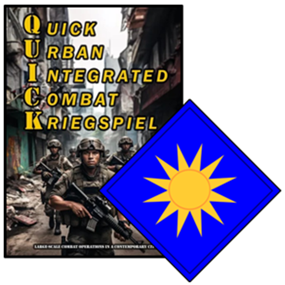
In early 2023, I finished designing the Quick Urban Integrated Combat Kriegspiel (QUICK), a game on LSCO in a large city, at the request of BG Robert Wooldridge (Deputy Commanding General – Operations, 40th Infantry Division) for use as a concluding exercise in the Urban Operations Planner Course. The game has been used twice in the July 2022 and May 2023 serials of the course and will be used in the August 2024 serial. It has received support from and has also been used by the Simulations Division at the U.S. Army Command and General Staff College.
This game led me to do a lot of research on current urban warfare doctrines, and attending the course itself confirmed what I had learned. I think the game teaches a number of points that are related to the learning objectives for the course. They are rather obvious individually, but in game form come together to display their overall and synergistic effects:
-
-
- Combined arms – task organization gives the force complementary abilities: This is the main thesis of the game, reflected in the Maneuver Unit + Enabler structure, where the Enablers provide additional combat power and capabilities peculiar to their nature.
-
-
-
-
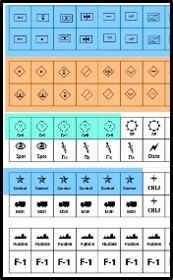
QUICK game counters, Brian Train via boardgamegeek.com Understanding tempo – speed vs casualties: One of the challenges in the game is deciding when and where to shift Enablers around, and to manage their cycle of exhaustion and renewal. In general, players find that the pace of this game is one with cyclic flurries of activity as both sides build up and prepare, then try to smash the enemy. In this respect it is rather like a siege, and I think this certainly fits what we’ve seen and heard in descriptions of modern urban battles.
-
-
-
-
- Urban terrain compresses units into much smaller spaces: The map for the next course serial shows much of downtown Manila, an area about 5 km tall and 4 km wide… and it swallows up an American division.
-
-
-
- Increased resource usage and casualties: The game does not have a detailed logistical system within it, but players are forced to think carefully about what they want to accomplish with the limited resources they have available each round (represented by cubes, and stepping through a matrix of action choices). The combat system is fairly bloody and once units start to get damaged and die off, your problems multiply.
-
-
-
- The higher ratio of attacker to defender required in urban operations: The defender is definitely given the advantage in combat in that they fire first, and both sides are docked combat power as they get progressively damaged. Terrain also affects combat strongly and large parts of the battlefield become rubbled during play.
-
-
-
- Civilian presence on the battlefield affecting Rules of Engagement (ROE) and information environment: The presence of civilians and mitigating harm to them is an important part of the course. The context of the
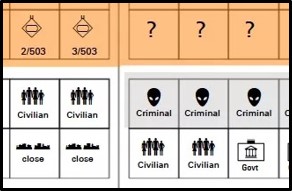
QUICK game counters, Brian Train via boardgamegeek.com game is kinetic combat so rubble and wandering civilian units appear during play. There is also a Fate Table for random events and the idea of Popular Support Table which shows how the civilian population can aid or hinder a force’s operations within a city, by providing intelligence or affecting movement or logistical operations.
- Civilian presence on the battlefield affecting Rules of Engagement (ROE) and information environment: The presence of civilians and mitigating harm to them is an important part of the course. The context of the
-
-
-
- Civilian infrastructure’s effect on military operations: The counter set in the game has markers for six types of explicit infrastructure identified in ATP 3-06, Urban Operations. The game is very free-form and scenarios can be put together that prioritize capture or protection of specific or all infrastructure, or optional rules that detail the effects of certain types of infrastructure being partly or totally destroyed.
-
What wargames do you find useful for learning about military operations?
I’m under no illusions that any commercially published, civilian market wargame could ever be more than a very vague approximation of actual military operations. Far too many critical aspects of operations – use of time and space, correlation of forces, limited intelligence, deception and above all logistics – are given less than a handwave (often just a finger!) in pursuit of “balance” and “fun.”

There seems to be a bit more acceptance than before about modern asymmetric conflicts and their complexity, with games on campaigns and specific battles in Afghanistan (A Distant Plain, Zurmat) and Iraq (Second Fallujah, We Are Coming Nineveh), and some reflection on hypothetical future wars (the Next War series, of course). These games can be great for Professional Military Education (PME) and making their players think about the complexity and possibilities of these situations without having to work out the details.
I think it is also possible to create games that do portray specific aspects of military operations that aren’t the sort of thing that would attract a hobbyist but would pose a challenge to professional players and let them explore problems and operational uncertainty without making them write out Course of Action (COA) evaluation worksheets over and over again. Examples I have created include:
-
-
- EXURB (a semi-abstract card game on the phases of the urban battle before the urban battle),
-
-
-
 91 DSSB (a 3-player cooperative game about life in a fictional Divisional Sustainment Support Battalion, trying to keep Brigade Combat Teams [BCTs] supplied), and
91 DSSB (a 3-player cooperative game about life in a fictional Divisional Sustainment Support Battalion, trying to keep Brigade Combat Teams [BCTs] supplied), and
-
-
-
- Sole Tunnels (a quick solitaire game about a rifle company exploring a tunnel complex full of traps and hostiles).
-
I found these fun to work on, and a few people have picked them up, but I don’t think they would ever be commercial successes. They could perhaps give a bit of insight.
If you could imagine the perfect wargame, what would it look like?
Someone once asked me how I would have designed A Distant Plain (Volko Ruhnke’s and my co-design on the Afghanistan war) if there were no constraints. I would, for a start:
-
-
- Increase the number of players to at least 20, each with slightly different agendas;
-
-
-
- Throw in an entire logistics/admin/troop training sub-game, which imposes its own restraints on play;
-
-
-
 Make players play the game for days on end, in little cells or alone, with incomplete information that usually isn’t shared at all, or transmitted inaccurately by several hostile umpires;
Make players play the game for days on end, in little cells or alone, with incomplete information that usually isn’t shared at all, or transmitted inaccurately by several hostile umpires;
-
-
-
- Hide the “true” victory conditions from one and all, so no one has a very good idea of just how well they are doing, though lying to each other would be encouraged; and
-
-
-
- From time to time, people would be randomly promoted over each other or just vanish from the game; and so on, and so on…
-
These are the pieces of “realism” that only rarely get picked up in hobby wargames, if at all. They often don’t show up in professional wargames played by the military either. Most players don’t like to play such games, either….
What Great Power peripheral flashpoints are you gaming?
The QUICK is set in downtown Manila, one of the largest and most densely populated cities on the planet.
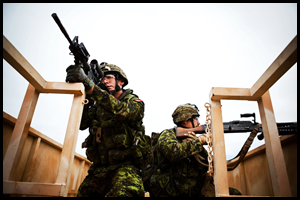 Recently I also created a scaled-down version of the QUICK for the commanding officer of a Canadian Army infantry battalion to show battle group level operations, set in the city of Daugavpils in southern Latvia. Right now, Canada is providing the headquarters and staff of a multi-national brigade there, so it’s possible that is where a Canadian battle group or brigade group would fight.
Recently I also created a scaled-down version of the QUICK for the commanding officer of a Canadian Army infantry battalion to show battle group level operations, set in the city of Daugavpils in southern Latvia. Right now, Canada is providing the headquarters and staff of a multi-national brigade there, so it’s possible that is where a Canadian battle group or brigade group would fight.
Several of my recent urban designs take place in or under generic large cities, to impress the general difficulty and density of the environment.
What emergent technologies or convergences are you integrating?
The central concept of the QUICK and some other recent designs of mine is that of task-organizing maneuver units and allocating enablers to them in order to carry out the task. Types of enablers include the usual combat arms but also show the capabilities of UAVs, Electronic Warfare, Military Intelligence, and Military Police detachments.
I think ground tactics now aren’t greatly different from 50 years ago, just greater distances and dispersion due to longer ranged and more deadly guns and missiles. Two changes that have come or are coming along here are:
-
-
- Sensor technology: Thermal imaging sights can “look” through smoke
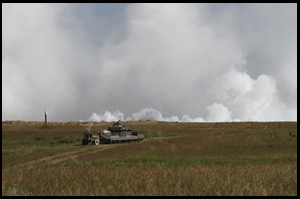 better than the Mark One Eyeball (though there are smokes that will degrade these too), and even underground or through walls to a limited extent.
better than the Mark One Eyeball (though there are smokes that will degrade these too), and even underground or through walls to a limited extent.
- Sensor technology: Thermal imaging sights can “look” through smoke
-
-
-
- Uncrewed remote or aerial spotting: A defended position can have remote “robot” sensors in different locations away from the position that don’t get smoked off, and would be able to see and send back observation data; or, if you find yourself in the middle of a smoke cloud you could launch a drone to fly out of it and have it see what’s going on for you, until it gets shot down or hit with Silly String or what have you.
-
Perhaps, in the fullness of time, actual soldiers will have a somewhat larger fraction of the godlike situational awareness we enjoy as hobby wargamers. Life may yet imitate Art!
What compelling insights from gaming would you most like to share with the U.S. Army?
Again, much of my work is on irregular combat and urban combat. I’m of course aware that the U.S. Army is pivoting away from that orientation [towards LSCO], but I still think that will be the default mode for future battles much of the time, and the Army will inevitably be called upon to respond to such situations. So, I don’t think gaming in that area should be dropped completely, since many of the technical advances that change and benefit LSCO also work on the irregular end of the spectrum. As a compromise too, I think there should be work encouraged to derive insights about hybrid or “grey zone” warfare…. I still have not encountered an interesting civilian market game on that form of warfare.
If you enjoyed this post, mark your calendars now to Save The Date:
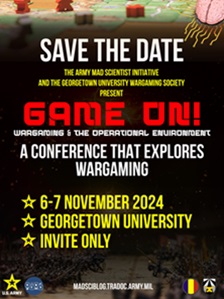 Who: Army Mad Scientist and the Georgetown University Wargaming Society want to invite you to our Game On! Wargaming & The Operational Environment Conference.
Who: Army Mad Scientist and the Georgetown University Wargaming Society want to invite you to our Game On! Wargaming & The Operational Environment Conference.
What: An in-person conference to explore Wargaming and how it can help the Army better understand the Operational Environment
When: 6-7 November 2024
Where: The Healey Family Student Center, Georgetown University, 3700 Tondorf Road, Washington, DC 20057
Why: To explore new wargaming methods, new ways to incorporate learning into Professional Military Education, and have an open dialogue with wargamers inside and outside the military.
***This conference is by invitation only. Be on the lookout for a follow-on email with a link for registration through Eventbrite. An agenda is being developed and will be available in the coming weeks.***
Stay tuned to the Mad Scientist Laboratory for conference updates and forward any questions you may have to madscitradoc@gmail.com
In the meantime, check out the following Mad Scientist Laboratory related content on:
Wargaming:
Calling All Wargamers & Wicked Problems Writing Contest, and associated podcast
Civilian Harm Mitigation and Response (CHMR) Considerations in Wargaming LSCO, by Andrew Olson
Live from D.C., it’s Fight Night (Parts One and Two) and associated podcasts (Parts One and Two)
Would You Like to Play a Game? Wargaming as a Learning Experience and Key Assumptions Check and “No Option is Excluded” — Using Wargaming to Envision a Chinese Assault on Taiwan, by Ian Sullivan
Using Wargames to Reconceptualize Military Power, by proclaimed Mad Scientist Caroline Duckworth
Gaming the System: How Wargames Shape our Future and associated podcast, with guest panelists Ian Sullivan, Mitchell Land, LTC Peter Soendergaard, Jennifer McArdle, Becca Wasser, Dr. Stacie Pettyjohn, Sebastian Bae, Dan Mahoney, and Jeff Hodges
The Storm After the Flood virtual wargame scenario, video, notes, and Lessons Learned presentation and video, presented by proclaimed Mad Scientists Dr. Gary Ackerman and Doug Clifford, The Center for Advanced Red Teaming, University at Albany, SUNY
Gamers Building the Future Force and associated podcast
Urban Combat:
TRADOC Pamphlet 525-92-1, The Changing Character of Warfare: The Urban Operational Environment, April 2020.
War in Ukraine: The Urban Fight is Happening Now and its associated podcast, and Ukraine: All Roads Lead to Urban and its associated podcast, with MAJ John Spencer (USA-Ret.)
Current and Future Operations in Megacities Conference: Observations and Recommendations, facilitated in Tokyo on 16-19 July 2019 — also review this conference’s complete Proceedings, as well as select speakers’ slide decks, presenter biographies, and conference agenda.
Megacities: Future Challenges and Responses, documenting key insights from the Multi Domain Battle (MDB) In Megacities Conference, facilitated at Fort Hamilton, New York, on 3-4 April 2018, as well as the agenda, presenter biographies, slide decks, associated videos of presentations, and conference Proceedings.
Dense Urban Environments (DUE): Now through 2050
Dense Urban Hackathon – Virtual Innovation
Irregular Warfare:
Learning from LSCO: Applying Lessons to Irregular Conflict, by Ian Sullivan and Kate Kilgore
Insights from the Israel-Hamas War and associated podcast, with LTC Kenneth Hardy
Ultimate Victory: Lessons on Future Warfare from Field-Marshal Viscount William Slim, by proclaimed Mad Scientist Luke Shabro
… and explore the TRADOC G-2‘s Operational Environment Enterprise web page, brimming with information on the OE and how our adversaries fight, including:
Our new The Operational Environment 2024-2034: Large-Scale Combat Operations.
Our China Landing Zone, full of information regarding our pacing challenge, including ATP 7-100.3, Chinese Tactics, BiteSize China weekly topics, People’s Liberation Army Ground Forces Quick Reference Guide, and our thirty-plus snapshots captured to date addressing what China is learning about the Operational Environment from Russia’s war against Ukraine (note that a DoD Common Access Card [CAC] is required to access this last link).
Our Russia Landing Zone, including the BiteSize Russia weekly topics. If you have a CAC, you’ll be especially interested in reviewing our weekly RUS-UKR Conflict Running Estimates and associated Narratives, capturing what we learned about the contemporary Russian way of war in Ukraine over the past two years and the ramifications for U.S. Army modernization across DOTMLPF-P.
Our Running Estimates SharePoint site (also requires a CAC to access), containing our monthly OE Running Estimates, associated Narratives, and the 2QFY24 and 3QFY24 OE Assessment TRADOC Intelligence Posts (TIPs).
Disclaimer: The views expressed in this blog post do not necessarily reflect those of the U.S. Department of Defense, Department of the Army, Army Futures Command (AFC), or Training and Doctrine Command (TRADOC).
About the Author: Brian Train is a freelance writer and game designer who has published over 65 games and many historical articles with a wide range of civilian publishers over the last 30 years. His special interests in game design are irregular and urban warfare, “pol-mil” games, and asymmetric games generally. He works as an Education Officer in the provincial government of British Columbia, Canada. Check out his game design blog here.

